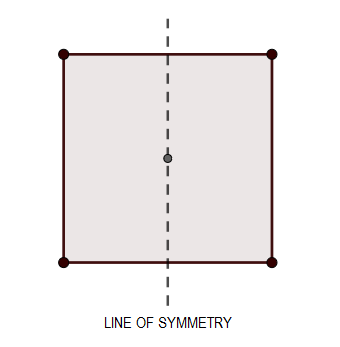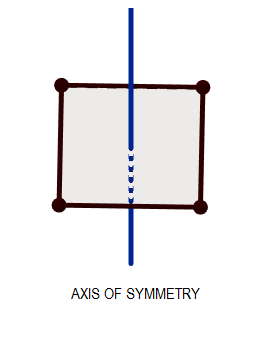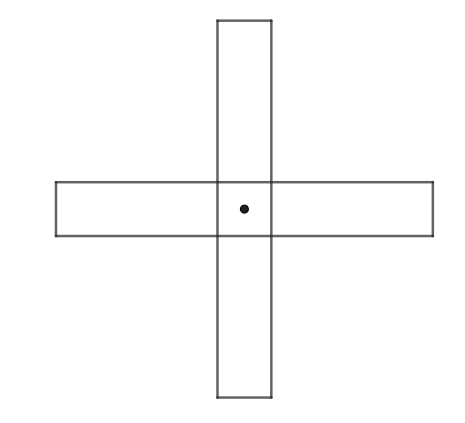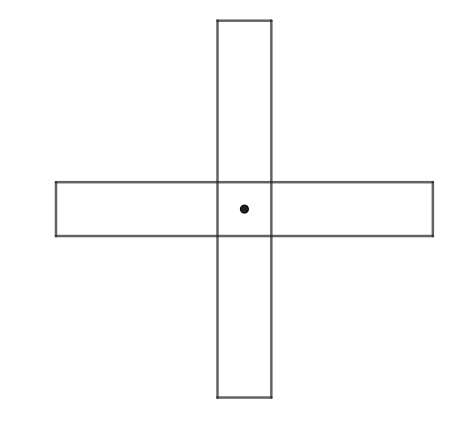Answer
412.2k+ views
Hint: Think of the basic definition of the axis of symmetry and think of the angle by which the rotation of the body about the given axis gives the exact identical figure to find the order of rotational symmetry.
Complete step-by-step answer:
Before starting with the solution, let us discuss the elements of symmetry and when a body is said to be symmetric or asymmetric. First, we will discuss the two major elements of symmetry, which are the line of symmetry and axis of symmetry.
The "Line of Symmetry" is the imaginary line through the body, which divides the body into two equal halves such that the parts on each side of the body are the mirror images of each other. While the axis of symmetry is an axis passing through the body about which the rotation of the body gives the exact identical figure as the initial one, provided the angle of rotation is less than , and the number of times the figure is repeated while rotating it by is the order of the rotational symmetry.
If a body consists of at least one of the elements of symmetry mentioned above is said to be symmetric. We can represent this diagrammatically as:


Now let us start the solution to the above question by drawing the diagram of the situation given in the figure.

Now, if we rotate the figure by $90{}^\circ $ about the axis passing through the centre marked in the figure and perpendicular to the plane of the paper, we will find the figure we get is exactly the same as the figure given. So, for every $90{}^\circ $ rotation, we get the same identical figure. Therefore, we can say that the order of rotational symmetry is equal to $\dfrac{360{}^\circ }{90{}^\circ }$ , which is equal to 4.
Note: Remember that it is possible that a figure can have multiple elements of symmetry. For example: a circle has an infinite number of lines of symmetry and one axis of rotational symmetry with infinite order of rotational symmetry. Also, remember that whenever the exact axis is not mentioned in the question, you need to always consider an axis passing through the centre of the figure and which is perpendicular to the plane of the figure.
Complete step-by-step answer:
Before starting with the solution, let us discuss the elements of symmetry and when a body is said to be symmetric or asymmetric. First, we will discuss the two major elements of symmetry, which are the line of symmetry and axis of symmetry.
The "Line of Symmetry" is the imaginary line through the body, which divides the body into two equal halves such that the parts on each side of the body are the mirror images of each other. While the axis of symmetry is an axis passing through the body about which the rotation of the body gives the exact identical figure as the initial one, provided the angle of rotation is less than , and the number of times the figure is repeated while rotating it by is the order of the rotational symmetry.
If a body consists of at least one of the elements of symmetry mentioned above is said to be symmetric. We can represent this diagrammatically as:


Now let us start the solution to the above question by drawing the diagram of the situation given in the figure.

Now, if we rotate the figure by $90{}^\circ $ about the axis passing through the centre marked in the figure and perpendicular to the plane of the paper, we will find the figure we get is exactly the same as the figure given. So, for every $90{}^\circ $ rotation, we get the same identical figure. Therefore, we can say that the order of rotational symmetry is equal to $\dfrac{360{}^\circ }{90{}^\circ }$ , which is equal to 4.
Note: Remember that it is possible that a figure can have multiple elements of symmetry. For example: a circle has an infinite number of lines of symmetry and one axis of rotational symmetry with infinite order of rotational symmetry. Also, remember that whenever the exact axis is not mentioned in the question, you need to always consider an axis passing through the centre of the figure and which is perpendicular to the plane of the figure.
Recently Updated Pages
The branch of science which deals with nature and natural class 10 physics CBSE

The Equation xxx + 2 is Satisfied when x is Equal to Class 10 Maths

Define absolute refractive index of a medium

Find out what do the algal bloom and redtides sign class 10 biology CBSE

Prove that the function fleft x right xn is continuous class 12 maths CBSE

Find the values of other five trigonometric functions class 10 maths CBSE

Trending doubts
Difference Between Plant Cell and Animal Cell

Difference between Prokaryotic cell and Eukaryotic class 11 biology CBSE

Fill the blanks with the suitable prepositions 1 The class 9 english CBSE

Change the following sentences into negative and interrogative class 10 english CBSE

Summary of the poem Where the Mind is Without Fear class 8 english CBSE

Give 10 examples for herbs , shrubs , climbers , creepers

Write an application to the principal requesting five class 10 english CBSE

What organs are located on the left side of your body class 11 biology CBSE

What is the z value for a 90 95 and 99 percent confidence class 11 maths CBSE




